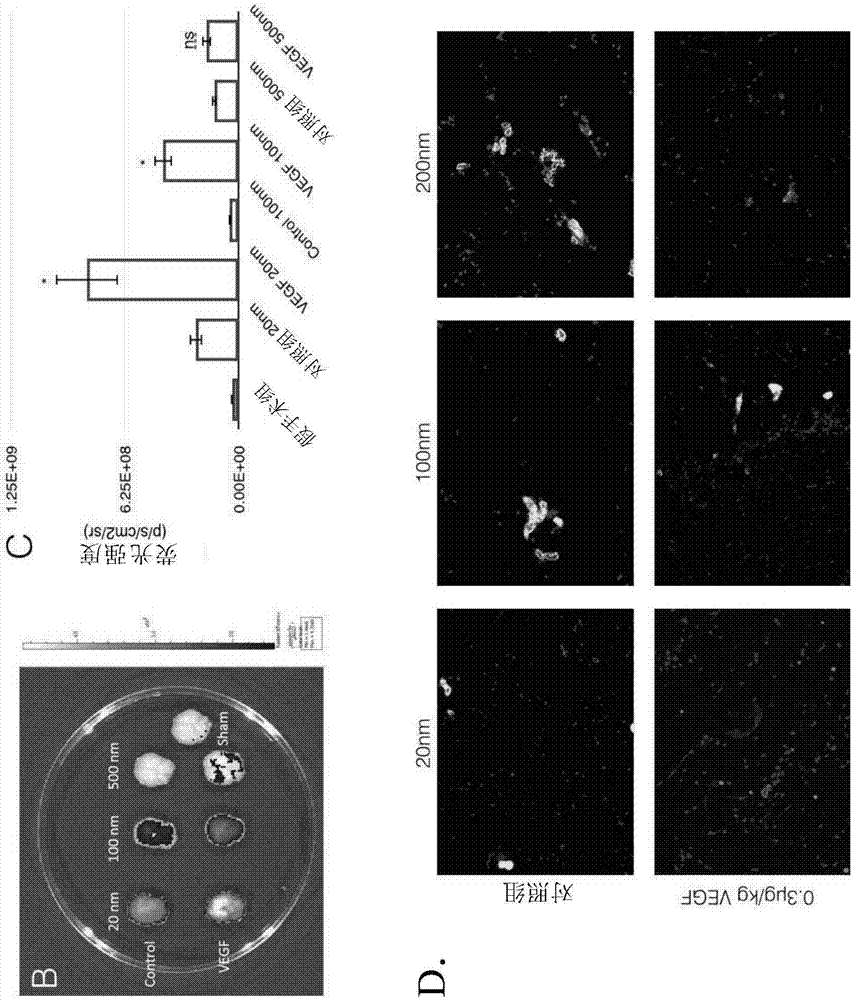Methods for enhancing permeability to blood-brain barrier and uses thereof
A kind of use, brain technology, applied in the field of enhancing the permeability of the blood-brain barrier and its use, can solve the problems of lack of drug delivery, low drug amount, and inability to trigger therapeutic responses of therapeutic compounds
- Summary
- Abstract
- Description
- Claims
- Application Information
AI Technical Summary
Problems solved by technology
Method used
Image
Examples
Embodiment 1
[0085] Example 1: VEGF can enhance blood-brain barrier barrier permeability in mouse model
[0086] Materials and methods
[0087] (i) Blood-brain barrier permeability was measured by the amount of Evans Blue (EB) exudation
[0088] The permeability of the blood-brain barrier was quantitatively assessed by Evans blue (Fluka). Evans blue (2% or 4% v / v in saline, 4ml / kg) was administered intravenously. For analysis of extravasation, perfuse 50 ml of 0.9% saline (containing 10 i.u. / ml of heparin) into the animal to remove intravascular dye until the body fluid sampled from the animal's arteries, kidneys, and liver is colorless until liquid. Then, the animal was sacrificed and its brain weight was weighed, and the brain tissue was homogenized in N,N-dimethylformamide (N,N-dimethylformamide) (Sigma-Aldrich Company) (1ml / 150mg tissue weight), It was incubated at 55° C. for 18 hours and centrifuged (14000 rpm / 20 minutes). The dye supernatant was analyzed spectrophotometrically...
Embodiment 2
[0109] Example 2: VEGF pretreatment can enhance the effect of hMSC-based cell therapy after stroke
[0110] Stroke A stroke (also known as a cerebrovascular accident (CVA) is a disturbance in the flow of blood to the brain, causing a rapid loss of brain function. There are two types of stroke: a hemorrhagic stroke or an ischemic stroke. Hemorrhagic stroke is caused by an acute intracranial hematoma caused by rupture of an intracranial artery. Ischemic stroke (also called cerebral infarction) is a blockage of blood flow to the brain (eg, thrombus or distal embolism) Caused by the death of brain cells in the region. Currently, the two standard treatments for ischemic stroke are thrombolytic injection and endovascular surgery. flow and quickly reduce hypoxic damage to brain tissue.
[0111] Mesenchymal stem cells (MSCs) are a heterogeneous population of pluripotent stromal stem cells that can differentiate into osteoblasts, chondrocytes and adipocytes. Previous studies have sho...
Embodiment 3
[0118] Example 3: VEGF pretreatment can delay the growth of brain tumors in mice treated with anticancer drugs and improve the survival rate of GBM mice
[0119] Glioblastoma multiform (GBM) (also known as grade 4 glioma) is the most common and aggressive type of malignant tumor in brain tissue. The current standard treatment for these tumors is a combination of surgical resection, radiation therapy and chemotherapy. GBM is highly aggressive and infiltrates healthy tissue, and by the time most patients are diagnosed with GBM, the tumor is often too large and disseminated for surgical removal. Therefore, even with modern treatments, the median survival rate of GBM patients is 12-15 months from the start of treatment, which is one of the lowest 5-year survival rates of all human cancers. Because of the low success rate of surgical resection, medical therapy is the most promising area of improvement. Appropriate anticancer drugs are currently available, but the blood-brain ba...
PUM
| Property | Measurement | Unit |
|---|---|---|
| diameter | aaaaa | aaaaa |
Abstract
Description
Claims
Application Information
 Login to View More
Login to View More - R&D
- Intellectual Property
- Life Sciences
- Materials
- Tech Scout
- Unparalleled Data Quality
- Higher Quality Content
- 60% Fewer Hallucinations
Browse by: Latest US Patents, China's latest patents, Technical Efficacy Thesaurus, Application Domain, Technology Topic, Popular Technical Reports.
© 2025 PatSnap. All rights reserved.Legal|Privacy policy|Modern Slavery Act Transparency Statement|Sitemap|About US| Contact US: help@patsnap.com



